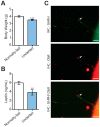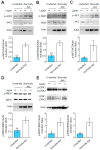Stimulation of GHRH Neuron Axon Growth by Leptin and Impact of Nutrition during Suckling in Mice
- PMID: 36904077
- PMCID: PMC10005278
- DOI: 10.3390/nu15051077
Stimulation of GHRH Neuron Axon Growth by Leptin and Impact of Nutrition during Suckling in Mice
Abstract
Nutrition during the early postnatal period can program the growth trajectory and adult size. Nutritionally regulated hormones are strongly suspected to be involved in this physiological regulation. Linear growth during the postnatal period is regulated by the neuroendocrine somatotropic axis, whose development is first controlled by GHRH neurons of the hypothalamus. Leptin that is secreted by adipocytes in proportion to fat mass is one of the most widely studied nutritional factors, with a programming effect in the hypothalamus. However, it remains unclear whether leptin stimulates the development of GHRH neurons directly. Using a Ghrh-eGFP mouse model, we show here that leptin can directly stimulate the axonal growth of GHRH neurons in vitro in arcuate explant cultures. Moreover, GHRH neurons in arcuate explants harvested from underfed pups were insensitive to the induction of axonal growth by leptin, whereas AgRP neurons in these explants were responsive to leptin treatment. This insensitivity was associated with altered activating capacities of the three JAK2, AKT and ERK signaling pathways. These results suggest that leptin may be a direct effector of linear growth programming by nutrition, and that the GHRH neuronal subpopulation may display a specific response to leptin in cases of underfeeding.
Keywords: GHRH; hypothalamus; leptin; linear growth; nutrition; somatotropic axis.
Conflict of interest statement
The authors declare no conflict of interest.
Figures





Similar articles
-
IGF-1 Induces GHRH Neuronal Axon Elongation during Early Postnatal Life in Mice.PLoS One. 2017 Jan 11;12(1):e0170083. doi: 10.1371/journal.pone.0170083. eCollection 2017. PLoS One. 2017. PMID: 28076448 Free PMC article.
-
Impact of insulin on primary arcuate neurons culture is dependent on early-postnatal nutritional status and neuronal subpopulation.PLoS One. 2018 Feb 21;13(2):e0193196. doi: 10.1371/journal.pone.0193196. eCollection 2018. PLoS One. 2018. PMID: 29466413 Free PMC article.
-
PDK1-FoxO1 pathway in AgRP neurons of arcuate nucleus promotes bone formation via GHRH-GH-IGF1 axis.Mol Metab. 2017 Feb 17;6(5):428-439. doi: 10.1016/j.molmet.2017.02.003. eCollection 2017 May. Mol Metab. 2017. PMID: 28462077 Free PMC article.
-
Growth hormone secretagogues and hypothalamic networks.Endocrine. 2001 Feb;14(1):1-8. doi: 10.1385/ENDO:14:1:001. Endocrine. 2001. PMID: 11322489 Review.
-
Electrophysiological actions of peripheral hormones on melanocortin neurons.Ann N Y Acad Sci. 2003 Jun;994:175-86. doi: 10.1111/j.1749-6632.2003.tb03178.x. Ann N Y Acad Sci. 2003. PMID: 12851314 Review.
Cited by
-
Regulating Integrin β1 to Restore Gonadotropin-Releasing Hormone-Tanycyte Unit Function in Polycystic Ovary Syndrome-Related Hypothalamic Dysregulation.Research (Wash D C). 2025 Feb 19;8:0619. doi: 10.34133/research.0619. eCollection 2025. Research (Wash D C). 2025. PMID: 39975575 Free PMC article.
-
Changes of Signaling Pathways in Hypothalamic Neurons with Aging.Curr Issues Mol Biol. 2023 Oct 12;45(10):8289-8308. doi: 10.3390/cimb45100523. Curr Issues Mol Biol. 2023. PMID: 37886966 Free PMC article. Review.
-
IGF-1 and insulin receptors in LepRb neurons jointly regulate body growth, bone mass, reproduction, and metabolism.bioRxiv [Preprint]. 2024 Sep 20:2024.09.20.614140. doi: 10.1101/2024.09.20.614140. bioRxiv. 2024. PMID: 39345425 Free PMC article. Preprint.
-
GHRH in diabetes and metabolism.Rev Endocr Metab Disord. 2025 Jun;26(3):413-426. doi: 10.1007/s11154-024-09930-9. Epub 2024 Nov 19. Rev Endocr Metab Disord. 2025. PMID: 39560873 Free PMC article. Review.
-
Growth hormone-releasing hormone and its analogues in health and disease.Nat Rev Endocrinol. 2025 Mar;21(3):180-195. doi: 10.1038/s41574-024-01052-1. Epub 2024 Nov 13. Nat Rev Endocrinol. 2025. PMID: 39537825 Review.
References
MeSH terms
Substances
Grants and funding
LinkOut - more resources
Full Text Sources
Miscellaneous

